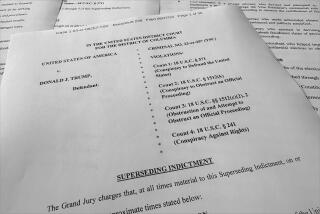Column: Think the 25th Amendment will take care of Trump? You’re dreaming.

- Share via
Just as his critics warned, President Trump is turning out to be unfit for his job, perhaps dangerously so. That’s a harsh judgment, but it’s no longer coming from the president’s opponents. It’s coming from leading members of his own party.
“We could be heading toward World War III with the kind of comments he’s making,” the chairman of the Senate Foreign Relations Committee, Bob Corker, said last week. Corker, who endorsed Trump during the presidential campaign, was only saying in public what other GOP figures have said in private. Secretary of State Rex Tillerson reportedly called his boss a “moron.” Others have used similar language off the record.
So it’s not surprising that speculation has renewed that Congress might try to remove Trump from office before his term ends.
According to one report, former White House advisor Steve Bannon even warned Trump that he risks being fired under the 25th Amendment to the Constitution. “What’s that?” the president purportedly replied.
If Congress isn’t happy with a president’s job performance, it doesn’t need to remove him. It has many ways to restrain his actions.
Like Trump, most Americans are more familiar with the law of impeachment, under which Congress can remove a president — after long debate and a formal trial — for “high crimes and misdemeanors.” To some Trump critics, the 25th Amendment looks more promising. But that’s wishful thinking.
“It’s easier to impeach than invoke the 25th Amendment,” the president of the National Constitution Center, Jeffrey Rosen, told me last week. That helps explain why no president’s opponents have even tried to use the measure before.
Ratified in 1967, the amendment provides a constitutional solution if a president is incapacitated by injury or illness. It was drafted after the assassination of President Kennedy in 1963, when members of Congress realized that an injured president in a coma would still be the only official empowered to command the nation’s nuclear arsenal.
Section 4 of the amendment provides that if the vice president and a majority of the Cabinet decide that the president is “unable to discharge the powers and duties of his office,” they can notify Congress that the vice president is taking over. If the president objects, Congress can vote on the question. A two-thirds majority in each house is required to remove the president from office.
There are two reasons that mechanism isn’t likely to be used against Trump.
The substantive reason is that the amendment was drafted with medical incapacity in mind, not general unfitness for office.
“If you read the debates … unpopularity is not included, poor judgment, incompetence, laziness, or impeachable conduct — none of that,” John D. Feerick, a professor at Fordham Law School who helped draft the amendment, said recently.
It would be up to the vice president, the Cabinet and Congress to decide whether the president was “unable” to do his job, but unless the evidence of his incapacity was overwhelming, they’d be touching off a constitutional crisis — and risking their political futures as well.
The procedural obstacles are even more immediate. The amendment is deliberately difficult to use. The first step is for the vice president and the Cabinet to decide the president needs to go — but they all got their jobs when Trump appointed them, remember?
And winning a two-thirds majority in each house of Congress is a virtually insuperable obstacle — at least as long as at least one house has a Republican majority.
“Any action to remove a president is politically traumatic,” congressional scholar Norman J. Ornstein said. “Any action they take will create a deep, deep division in their party. They’re going to avoid it as long as they can.”
There’s one alternative route in the amendment: Instead of the Cabinet, Congress can establish a disability review commission to determine whether the president is unfit. But even if such a board pronounced Trump unfit, they would still need the vice president to agree, as well as a two-thirds majority in each House.
Impeachment, by contrast, doesn’t require the vice president’s assent, and needs only a majority in the House, not two-thirds. That’s not going to happen in a House with a Republican majority, but if Democrats win control of the chamber in 2018, it would suddenly become feasible.
Trump has already provided his opponents with plenty of issues they could cast as impeachable offenses: His failure to divest his family business, the profits his hotels have made from foreign governments, his apparent carelessness with classified information, his potential obstruction of justice by firing former FBI Director James B. Comey. And Congress can define “high crimes and misdemeanors” any way it wants. A president’s actions don’t need to be felonies under the criminal code to be considered as grounds for impeachment — although it helps to make a case.
Of course, if Congress isn’t happy with a president’s job performance, it doesn’t need to remove him. It has many ways to restrain his actions. It can overturn executive orders. It can impose spending limits. It can even legislate.
Meanwhile, the most practical way for Trump’s opponents to get him out of office remains the traditional way: to vote him out in 2020, in either the Republican primaries or the general election.
The 25th Amendment? That’s the hardest way of all.
Follow the Opinion section on Twitter @latimesopinion or Facebook
More to Read
A cure for the common opinion
Get thought-provoking perspectives with our weekly newsletter.
You may occasionally receive promotional content from the Los Angeles Times.











